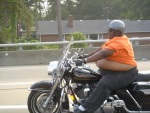|
So I just recently picked up a '17 CX5. I love it, except for one thing. It turns out the drivers seat doesn't agree with me. It was comfortable on the test drive, but after driving a bit more it seems like it's hitting a spot on my outer rear end. It will get tingly/painful there and kind of spread down my leg. I'm an average sized dude so it's not like a weight thing, it just seems like the bolsters are hitting a bad spot? Anyway, anyone have any suggestions? It really sucks because I love everything else about the car but this is really souring me on it.
|
|
|
|

|
| # ? Jun 3, 2024 19:36 |
|
Deteriorata posted:Keeping the wheels turning while braking is important to maintaining control. High-traction road surfaces allow for higher braking forces without losing the grip on the road. "Grip" is defined by the coefficient of Right, great, I do understand it after all. I guess there's nuance in terms of small slips reducing effective braking, not just huge skids, but at least I understand the principle.
|
|
|
|
Jaded Burnout posted:Right, great, I do understand it after all. I guess there's nuance in terms of small slips reducing effective braking, not just huge skids, but at least I understand the principle. Skidding gets you the fastest braking, but when you're skidding you don't have any control over where the car goes. So for maximum effective braking, you want to stay just under the limit of where the tires break loose. Anti-lock brakes work by sensing the wheel rotation. When the rotation stops, the wheel is skidding so it releases the brakes for a moment, allowing the tire to get grip again. It then reapplies the brakes until the wheel stops once again. It can do that hundreds of times per second, to keep you right at the edge of traction - maximum braking while retaining steering control.
|
|
|
|
Deteriorata posted:Skidding gets you the fastest braking, but when you're skidding you don't have any control over where the car goes. So for maximum effective braking, you want to stay just under the limit of where the tires break loose. Nah, you could brake harder if you could stay just below the skidding threshold (which isnít quite what ABS does, but similar). This is because the coefficient of static friction is greater than the coefficient of sliding friction. Practical demonstration: it takes more force to get a cardboard box sliding on carpet than it takes to keep the box moving.
|
|
|
|
What's the easiest way to replace a rear main seal? I have the motor on a stand right now, and I guess I could probably unbolt the flex-plate and get at the seal but that seems awkward. Should I just lower the engine onto some blocks of wood to replace the seal quickly before putting it back into the car? Am I missing something obvious?
|
|
|
|
You mean like what type of car and what engine?
|
|
|
|
My steering wheel is rotated left about 10* when I'm going straight. The previous owner had dealer perform recall service on the steering wheel about 45k miles and 4 years ago that was supposed to include fixing the off center condition. Should I just ignore it until I eventually get new tires and an alignment?
|
|
|
|
Josh Lyman posted:My steering wheel is rotated left about 10* when I'm going straight. The previous owner had dealer perform recall service on the steering wheel about 45k miles and 4 years ago that was supposed to include fixing the off center condition. As long as the front tires are not wearing unusually fast it can be ignored until you want to deal with it. Don't even bother going back to the dealer to try and have them fix it for free, too much time/miles/ownership change for them to touch it.
|
|
|
|
monsterzero posted:What's the easiest way to replace a rear main seal? I have the motor on a stand right now, and I guess I could probably unbolt the flex-plate and get at the seal but that seems awkward. Should I just lower the engine onto some blocks of wood to replace the seal quickly before putting it back into the car? Am I missing something obvious? If it's a one-piece seal, you have to remove the flexplate because the seal comes off the back. If it's a two piece seal, you can take the oil pan off, take the rear main cap off, and do each half from there. Godholio posted:You mean like what type of car and what engine? Yea that would be more helpful for specific advice There's probably someone in here who has done whatever particular kind you have
|
|
|
|
It's a Subaru EZ30D from a 2004 Outback and it has a one piece seal. I get how the seal is replaced, I'm more interested in general advice on how to work around the engine stand. It bolts to the back of the engine and makes the flex plate bolts hard to get at, and would probably prevent me from driving in the new seal.
|
|
|
|
monsterzero posted:It's a Subaru EZ30D from a 2004 Outback and it has a one piece seal. I get how the seal is replaced, I'm more interested in general advice on how to work around the engine stand. It bolts to the back of the engine and makes the flex plate bolts hard to get at, and would probably prevent me from driving in the new seal. Oh yeah, we were just talking about your car. Durr. What I would do is pick the engine up with the hoist, take the stand all the way off, and use the impact to get the flexplate bolts off without jerking the motor around. If that's not possible, set it down on a tire and use a breaker bar. E: Dunno about the seal replacement. Don't a lot of them use a tool that presses it on from the crankshaft bolt holes? You shouldn't hammer on the end of the crank anyway. If you insist, yeah you'll have to set it down on something, preferably with some of the weight still on the hoist to keep it upright. Raluek fucked around with this message at 06:19 on Jul 24, 2017 |
|
|
|
Raluek posted:Oh yeah, we were just talking about your car. Durr. What I would do is pick the engine up with the hoist, take the stand all the way off, and use the impact to get the flexplate bolts off without jerking the motor around. If that's not possible, set it down on a tire and use a breaker bar. Yeah, I could try to work on the hoist but that seems sketch. I do have an old tire so I might use that to support the motor. Thanks. The special service tools for the job are a guide that bolts to the crank and a large cup that fits over that and presses the seal in. No hammering on the crank, you hit the cup.
|
|
|
|
Deteriorata posted:Skidding gets you the fastest braking, but when you're skidding you don't have any control over where the car goes. So for maximum effective braking, you want to stay just under the limit of where the tires break loose. Not a direct response the earlier breaking question but on the subject of anti-lock breaks; they are amazing but also fall into the same category as seat belts where some people will say they don't need them because "it just gets in the way of my pure driving skill". At least now they're so common most people don't really think about them anymore (although you can see the same ABS debate in motorcycles today, a repeat of the debate from 20-30 years ago in cars). I'd guess most younger people today have never panick stopped a car that didn't have ABS. Be glad: https://www.youtube.com/watch?v=KGkKDaYd3Mo
|
|
|
|
Jack B Nimble posted:I'd guess most younger people today have never panick stopped a car that didn't have ABS. Be glad: I've only ever had to do one true panic stop, and it was in a car without ABS. I think the only reason it didn't go badly is because it was in a Miata, and I had to do a minimum of turning while braking (shifted over one lane). In those conditions it wasn't too bad to modulate the brakes. In conditions like that, a good driver on the street can probably match ABS, and an excellent driver (one with significant threshold braking experience) might even beat it. I'd bet that difference is smaller than ever today with modern ABS systems. In just about every other conceivable condition, with worse road conditions, worse drivers, and better ABS setups, I'd expect ABS to win every time. The age of the ABS implementation shouldn't be ignored. I'd trust any modern system but some of the early ABS setups were pretty poo poo. The ABS in the '92 Corsica I drove for a while - much like everything else in the car - was a dangerous piece of poo poo.
|
|
|
|
IOwnCalculus posted:I've only ever had to do one true panic stop, and it was in a car without ABS. I think the only reason it didn't go badly is because it was in a Miata, and I had to do a minimum of turning while braking (shifted over one lane). In those conditions it wasn't too bad to modulate the brakes. In pre-ABS days, we were taught to just ram the brake pedal to the floor and skid if it was a true panic. Less than that, we were to pump the brake pedal - push to the point of skidding, then let up and push again, which is effectively what the ABS systems do only 1000x faster. The point of skidding was that you actually stop faster than trying to pump the brakes manually. You lose control of the car, though - but if you're going to collide with something anyway, there's little lost. In the transition period, there were lots of PSAs about just jamming the brake to the floor in an emergency and letting the new-fangled ABS take care of the pumping for you.
|
|
|
|
I dunno who taught you that, but it's patently untrue. Stopping force is equal to weight (same in all cases) times the coefficient of friction. For rubber on dry asphalt the static coefficient is about 0.9, kinetic (sliding) coefficient is between .4 and .8. So your sliding force is between 45% and 88% less than peak static braking force. Maaybe in the best case achieving that .8 sliding is easier than getting to the .9 static, but look at how wide that variation is; are you gonna roll the dice to find out that oops, in today's weather condition with these tires you're getting the .4 instead? And stop half as fast, while also spinning across the highway? Maybe in ye olden tymes when you were dealing with cable-operated drums that had horrible feedback it could be argued for, but for any reasonable modern system, and by modern i mean the mid 1960s when hydraulic brakes were universal and power assist and front discs were becoming commonplace, even a novice is better off trying to prevent skidding than just mashing to the floor and letting jesus take the wheel. I've talked cars with a lot of my older family, and on the topic of panic stops every single one of them mentions being taught to pump the brakes; not once have I ever heard of being taught to intentionally put your car into a slide to stop faster. I think anyone with an ounce of common sense realizes it's better to keep control of your car at the expense of a little braking speed.
|
|
|
|
Enourmo posted:I dunno who taught you that, but it's patently untrue. Stopping force is equal to weight (same in all cases) times the coefficient of friction. For rubber on dry asphalt the static coefficient is about 0.9, kinetic (sliding) coefficient is between .4 and .8. So your sliding force is between 45% and 88% less than peak static braking force. Maaybe in the best case achieving that .8 sliding is easier than getting to the .9 static, but look at how wide that variation is; are you gonna roll the dice to find out that oops, in today's weather condition with these tires you're getting the .4 instead? And stop half as fast, while also spinning across the highway? Pumping the brakes caused two problems - a lot of people weren't actually very fast at it and couldn't modulate it very well. Additionally, in a panic situation having too many things to think about can make your brain lock up. Locking up the brakes was advocated as a fail-safe if you didn't know what else to do. The reality was that a lot of people weren't very good at panic stops. The skidding recommendation was a concession to reality, essentially. It was put in the form of "pumping the brakes is best, but if you've got too much to handle, just lock them up." It was directly stated in a lecture from a state highway patrol officer during my drivers' ed classes, by the way.
|
|
|
|
I guess that just seems like bad advice all around, but then I grew up after ABS came out so who knows.
|
|
|
|
Deteriorata posted:Pumping the brakes caused two problems - a lot of people weren't actually very fast at it and couldn't modulate it very well. Additionally, in a panic situation having too many things to think about can make your brain lock up. Locking up the brakes was advocated as a fail-safe if you didn't know what else to do. I suspect that may have been Trooper Smith's personal opinion. I doubt your textbook book recommended that. Both my formal schooling (1983, well before near-universal ABS use) and parental training taught threshold braking for dry and wet, pumping for snow and ice. Locking up the brakes was not only never taught, but specifically discouraged.
|
|
|
|
Most bike are still non abs and threshold braking is what they recommend. How many people can really do it, eeeh. It takes some serious practice, if I'm honest I'd probably err more on the side of not locking up the brakes than using every bit of brake. But that's more of a bike thing.
Jack B Nimble fucked around with this message at 16:50 on Jul 24, 2017 |
|
|
|
joat mon posted:I suspect that may have been Trooper Smith's personal opinion. I doubt your textbook book recommended that. Both my formal schooling (1983, well before near-universal ABS use) and parental training taught threshold braking for dry and wet, pumping for snow and ice. Locking up the brakes was not only never taught, but specifically discouraged. Aren't you supposed to lock the brakes in thick snow?
|
|
|
|
spog posted:Aren't you supposed to lock the brakes in thick snow? Yes, potentially wet snow or hard packed snow or gravel, the idea is to build a wedge of material in front of the wheel. Driver's ed class didn't get into that level of specialty driving. I've tried both ways, and threshold braking still seemed to work better, even for straight ahead braking only. (because by locking up, you're still ceding directional control)
|
|
|
|
joat mon posted:I suspect that may have been Trooper Smith's personal opinion. I doubt your textbook book recommended that. Both my formal schooling (1983, well before near-universal ABS use) and parental training taught threshold braking for dry and wet, pumping for snow and ice. Locking up the brakes was not only never taught, but specifically discouraged. The context was that he said he had seen far too many wrecks where the drivers did no braking at all, with the drivers saying they were too busy with other stuff to focus on pumping the brakes properly. Hence his recommendation that locking the brakes and skidding is better than doing nothing - it will stop your car eventually and doesn't require any extended thought.
|
|
|
|
Jack B Nimble posted:I can get the loop through, the part that catches is that plastic .... double flange? If the answer is just to pull it through I can through what was plan 1 before I got scared, push the loop through and pull the rest through with needle nose pliers. Any luck on the hood? I can send some pics of what it's supposed to look like if it'll help...
|
|
|
|
joat mon posted:Any luck on the hood? I can send some pics of what it's supposed to look like if it'll help... Thanks for asking, I gave it some experimental taps with a dead blow hammer but the joint didn't move, I didn't wail on it since I was just guessing at the issue. I'll post some pictures when I get home, I planned on working on it some more Sunday but life. But if it makes any sense, there are some stops on the hinge that I noticed years ago, that never actually touch the hinge if you open the hood - well now the hinge is right up on the stops and won't go back down. Grabbing the front of the hood and pulling hard just bent the hood a bit, right where the hinge bolts on. There may be a latch or lock that I need to release. Or I may just need to hit the hinge harder, but that is the halfassery that earned me a bent hood. Edit: https://www.f150forum.com/f91/hood-stuck-open-any-suggestions-223155/ suggests it's just stuck, though helpfully it says try lateral motion as well. Jack B Nimble fucked around with this message at 19:37 on Jul 24, 2017 |
|
|
|
'14 Chevrolet Cruze LT My check engine light came on, I took it to the garage and it gave them a PO#449 code It came on again when I started the car, he told me it wasn't a huge deal. I'd prefer not to have the check engine light on, and would like to get it repaired. How much can I expect to pay and is it something I should do sooner than later?
|
|
|
|
Friend's '08 civic's running lights are out but everything else works, brake lights, hazards, turn signals. He replaced the bulbs but that didn't do anything so I'm guessing I need to check the fuses and possibly look for shorts? Does backprobing the bulb sockets help? What kind of voltages should I see there?
|
|
|
|
Razzled posted:Friend's '08 civic's running lights are out but everything else works, brake lights, hazards, turn signals. at least 12 volts.
|
|
|
|
Professor Shark posted:'14 Chevrolet Cruze LT https://repairpal.com/obd-ii-code-P0449 EVAP codes can be annoying to diagnose if a gas cap replacement doesn't solve it. Shockingly I'm not a mechanic, but I disagree with the guy that it should be ignored, especially on such a new vehicle. How many miles on the Cruze? I would recommend going to another shop with good reviews on Yelp. 2014 Cruzes came with a 3yr/36k mile complete warranty, and longer powertrain. You could call the dealer and ask if this would be included in warranty service. Michael Scott fucked around with this message at 20:13 on Jul 24, 2017 |
|
|
|
Michael Scott posted:https://repairpal.com/obd-ii-code-P0449 62,325 kilometers I'm in a rural area with few choices to bring it to, it's basically this place or the closest dealership, an hour and a half away
|
|
|
|
Well a plus with a dealer is they give you a loaner. So if they tell you it would be free, you'll have to evaluate how much your time is worth. Since you're not in the US, I imagine the warranty is even longer.
|
|
|
|
Professor Shark posted:62,325 kilometers There's two ways to fix this if it's not the gas cap. 1. Do it properly, smoke test the emissions tubes, electrical test components. It's costs time and money for a really proper diagnosis. 2. Throw random emissions parts at it randomly a hope it fixes it. Most people choose #2 and get mad at the mechanic when it doesn't work. EDIT: GM Canada/chevrolet has only a 3 year, 60,000km warranty on emissions systems.
|
|
|
|
0toShifty posted:2. Throw random emissions parts at it randomly a hope it fixes it. I think that this is his plan, replace and see what works... I don't know if they're set up for #1, but I can ask them about it?
|
|
|
|
Professor Shark posted:I think that this is his plan, replace and see what works... I don't know if they're set up for #1, but I can ask them about it? I had a car that threw this code all the time, and it drove everyone involved nuts. They replaced the gas cap, the charcoal canister, all the evaporative emissions stuff and it still came on. I finally concluded it must be something in the filler neck itself that was keeping the gas cap from sealing properly - either it was out of round, or the lip was uneven, or something like that. I tried rubbing ski wax all over it and sure enough, the cap sealed and the CEL went away. I kept rewaxing it periodically for the life of the car. Ski wax isn't magic, by the way. Try anything like it, maybe even Vaseline or candle wax. It may do the trick for you.
|
|
|
|
I really hope that will be my last resort. I was really enjoying not having car trouble for this last year and change, I hope that replacing the charcoal canister/ hose will fix it
|
|
|
|
Ok, throwing a gear reduction starter on my X1/9, and I cannot get the motor to spin while mounted in the car. Only the solenoid clicks Currently, I have R/R+B going to the spade connector (surrounded in cardboard below)and G/B going to the post as that's the way it is on the stock Marelli starter  (not my picture, but same model of starter. Also, the complete contents of the package I received) I took it back out and bench tested it, and still only the solenoid engaged. I decided to throw in a connection between the spade connector and grounding post before I returned it, which finally got both solenoid and starter to engage. So what do I do to get it to work while attached to the car itself? There were no instructions included with my starter and searching Xweb only shows people having a similar issue with the carbureted wiring harness, while mine is FI
|
|
|
|
Razzled posted:Friend's '08 civic's running lights are out but everything else works, brake lights, hazards, turn signals. Fuse is a possibility, I'd be shocked if the running lights were on a separate sircuit from headlights though. If they both suddenly failed I'd suspect a single point of failure, specifically either the switch or relay (if it uses a relay). Switch is relatively easy, unplug the connector (usually in the steering column) and check continuity with the switch on and off. Relays are a little more complicated to test but you can google it.
|
|
|
|
Jack B Nimble posted:Thanks for asking, I gave it some experimental taps with a dead blow hammer but the joint didn't move, I didn't wail on it since I was just guessing at the issue. I'll post some pictures when I get home, I planned on working on it some more Sunday but life. I've never seen a latch or anything that was designed to hold the hood up like that. It's probably just overextended/bent. Are you going to get a junkyard hood for it? If so, maybe consider taking the hinges with the new hood, and unbolt the whole hood/hinge mess from your truck as-is. monsterzero posted:Yeah, I could try to work on the hoist but that seems sketch. I do have an old tire so I might use that to support the motor. Thanks. I still don't like the idea of hitting anything that transmits force into the crankshaft, since the thrust bearing probably won't like impact loads. If there's any way to slowly press it, I'd think that's ideal? Like how you don't ever hammer on harmonic balancers, you always press them on with that special tool.
|
|
|
|
Please tell me if I am crazy. Living in NYC, moving to California and will need a car when I get there. I wanted something reliable, boring, and older around $3-4k for a daily driver in la to at least get me going for awhile. Would a 90-91 Volvo 240 wagon be a good choice? They seen to run forever. Am I totally out of my mind? Should I just get a used Toyota or something?
|
|
|
|

|
| # ? Jun 3, 2024 19:36 |
|
cods posted:Please tell me if I am crazy. A 30-year-old Volvo will certainly be old and boring, but any car that old will not be very reliable. Look for something around 10 years old.
|
|
|
































